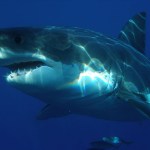zebrafish
Photo of zebrafish housed at a research institute. By Karol Głąb CC BY-SA 3.0. via Wikimedia Commons
Who would have thought tiny fish could lead to big advances in medicine? Zebrafish (Danio rerio) and mammals have similar anatomy and physiology of the brain, eyes, gut, and cardiovascular systems. Some of the reasons why these fish are good models to understand cardiovascular physiology were recently explored in a new article published in Physiological Reviews.
Animal models are used in research that seeks to understand both normal physiological mechanisms as well as mechanisms…
I came across this neat video from Mayo Clinic researcher Dr. Michael Romero, a comparative physiologist interested in how the kidneys work. In this video he describes discoveries made in zebrafish that relate to human kidney function:
Image of a zebrafish larva from (NHGRI Press Photos).
Calcium is very important for the normal development, growth and survival of most vertebrates. Therefore, regulation of calcium intake and disposal is well-controlled. Mammals obtain most of their calcium from the diet, whereas fish obtain calcium by absorbing it from the external environment. For adults, this occurs in the gills and for larvae it is absorbed through the skin. What this means is that fish living in low calcium environments can acclimate by increasing the absorption of calcium from the water.
Dr. Kwong (Dept. of…
Image of a great white shark from Wikimedia Commons.
Dr. Michael Stanhope from Cornell University has discovered that great white sharks actually share more proteins involved in metabolism and biochemistry in common with humans than zebrafish, a common fish model used in biomedical research. They made this discovery by sequencing the transcriptome of a heart isolated from a great white shark. I find it fascinating that sharks have more proteins in common with mammals than with bony fish, even though sharks and bony fish are not very closely related.
Source:
Cornell University Press
Not Exactly Pocket Science is a set of shorter write-ups on new stories with links to more detailed takes by the world's best journalists and bloggers. It is meant to complement the usual fare of detailed pieces that are typical for this blog.
Cold-proof tongue allows early chameleon to catch early insect
Chameleons are some of the most versatile of lizards. They live in baking deserts and freezing mountaintops and part of their success hinges on a weapon that works just as well in the warmth as in the cold - its tongue. Relying on stored elastic power for its ballistic strike, the…
You're looking at the face of a new species of fish and judging by the two fearsome fangs, you'll probably understand how it got its scientific name - Danionella dracula. The teeth do look terrifying but fortunately, their owner is a tiny animal just 15 millimetres long. Ralf Britz from London's Natural History Museum discovered the fanged fish in a small stream in northern Burma, just two years ago. The more he studied them, the more he realised that they are physically extraordinary in many ways.
For a start, those are no ordinary teeth - they are actually just part of the fish's jawbone…

